stop start RENAULT TWIZY 2017 1.G Owners Manual
[x] Cancel search | Manufacturer: RENAULT, Model Year: 2017, Model line: TWIZY, Model: RENAULT TWIZY 2017 1.GPages: 118, PDF Size: 2.48 MB
Page 19 of 118
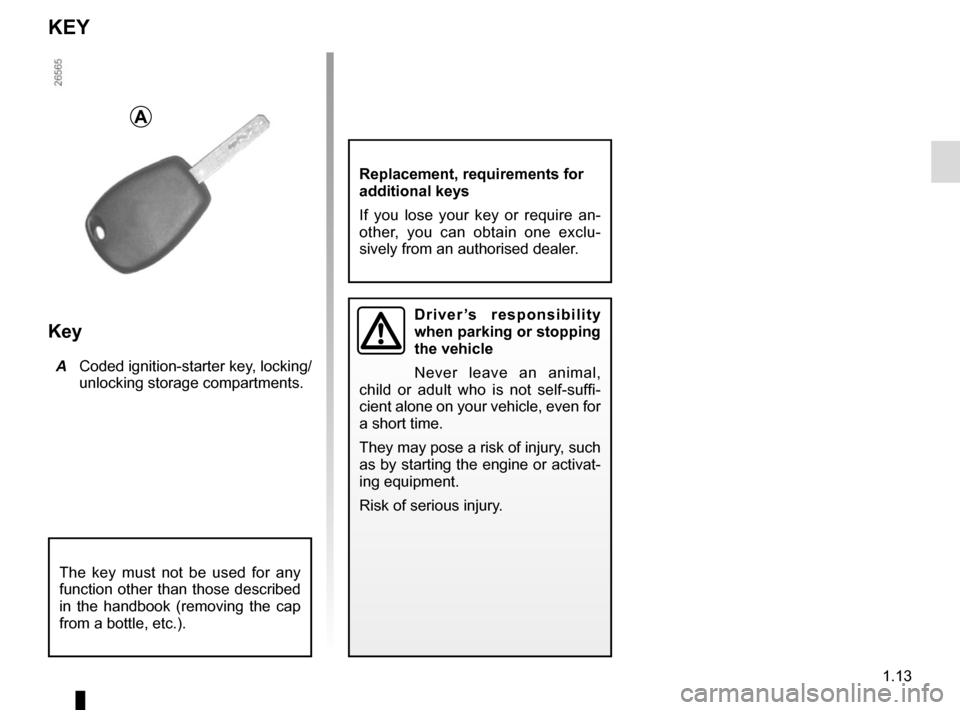
1.13
KEY
Key
A Coded ignition-starter key, locking/
unlocking storage compartments.
The key must not be used for any
function other than those described
in the handbook (removing the cap
from a bottle, etc.).
Replacement, requirements for
additional keys
If you lose your key or require an-
other, you can obtain one exclu-
sively from an authorised dealer.
A
Driver’s responsibility
when parking or stopping
the vehicle
Never leave an animal,
child or adult who is not self-suffi-
cient alone on your vehicle, even for
a short time.
They may pose a risk of injury, such
as by starting the engine or activat-
ing equipment.
Risk of serious injury.
Page 20 of 118
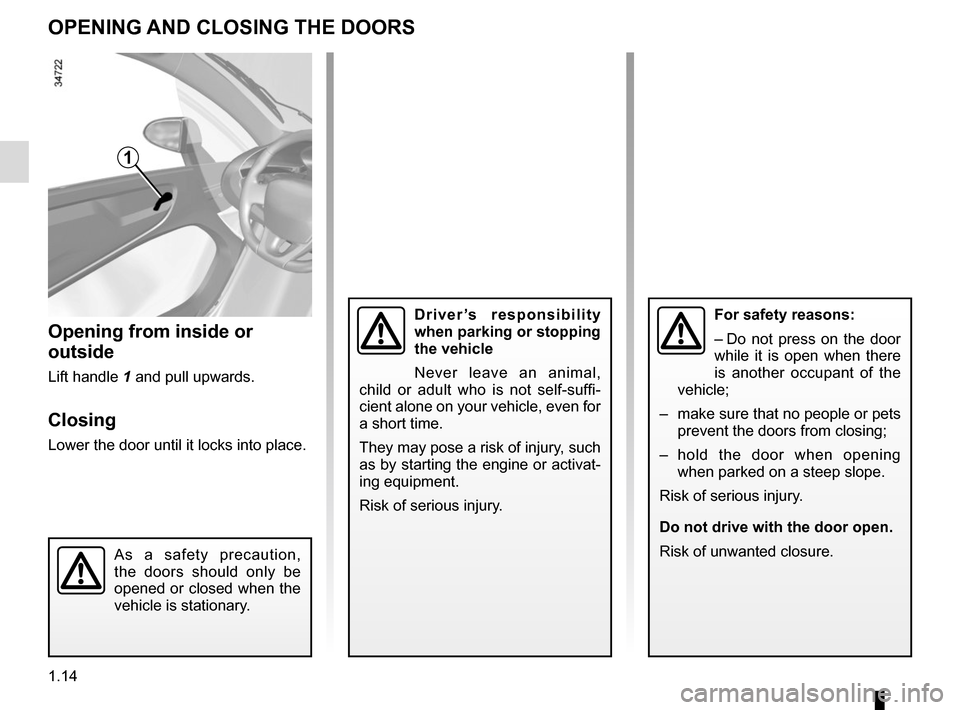
1.14
OPENING AND CLOSING THE DOORS
Opening from inside or
outside
Lift handle 1 and pull upwards.
Closing
Lower the door until it locks into place.
1
As a safety precaution,
the doors should only be
opened or closed when the
vehicle is stationary.
For safety reasons:
– Do not press on the door
while it is open when there
is another occupant of the
vehicle;
– make sure that no people or pets prevent the doors from closing;
– hold the door when opening when parked on a steep slope.
Risk of serious injury.
Do not drive with the door open.
Risk of unwanted closure.Driver’s responsibility
when parking or stopping
the vehicle
Never leave an animal,
child or adult who is not self-suffi-
cient alone on your vehicle, even for
a short time.
They may pose a risk of injury, such
as by starting the engine or activat-
ing equipment.
Risk of serious injury.
Page 21 of 118
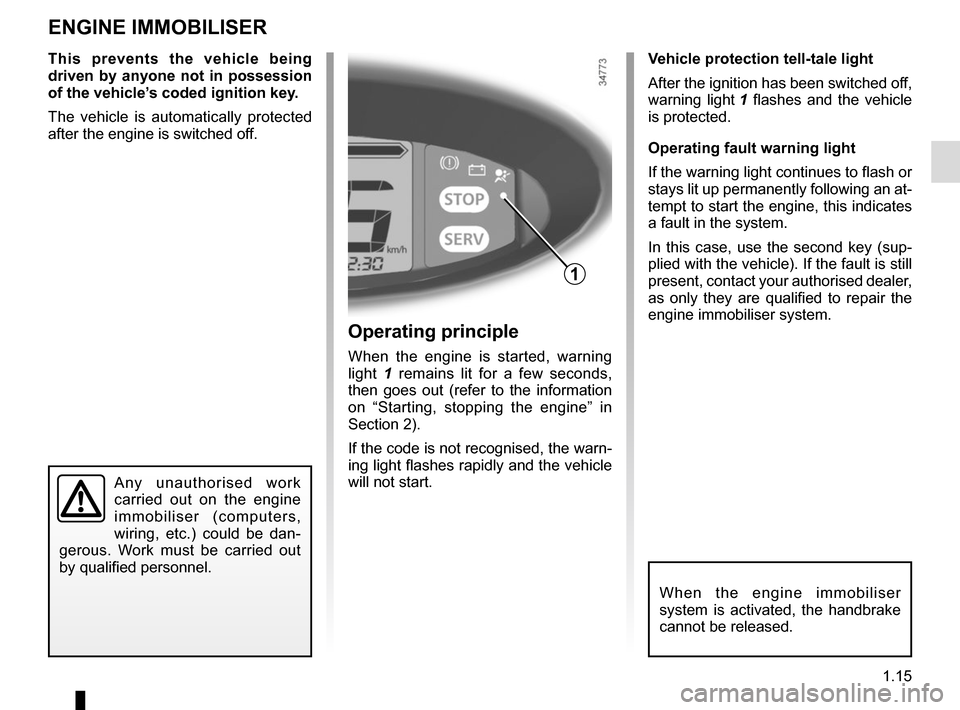
1.15
ENGINE IMMOBILISER
This prevents the vehicle being
driven by anyone not in possession
of the vehicle’s coded ignition key.
The vehicle is automatically protected
after the engine is switched off.
Any unauthorised work
carried out on the engine
immobiliser (computers,
wiring, etc.) could be dan-
gerous. Work must be carried out
by qualified personnel.
Operating principle
When the engine is started, warning
light 1 remains lit for a few seconds,
then goes out (refer to the information
on “Starting, stopping the engine” in
Section 2).
If the code is not recognised, the warn-
ing light flashes rapidly and the vehicle
will not start. Vehicle protection tell-tale light
After the ignition has been switched off,
warning light
1 flashes and the vehicle
is protected.
Operating fault warning light
If the warning light continues to flash or
stays lit up permanently following an at-
tempt to start the engine, this indicates
a fault in the system.
In this case, use the second key (sup-
plied with the vehicle). If the fault is still
present, contact your authorised dealer,
as only they are qualified to repair the
engine immobiliser system.
1
When the engine immobiliser
system is activated, the handbrake
cannot be released.
Page 30 of 118
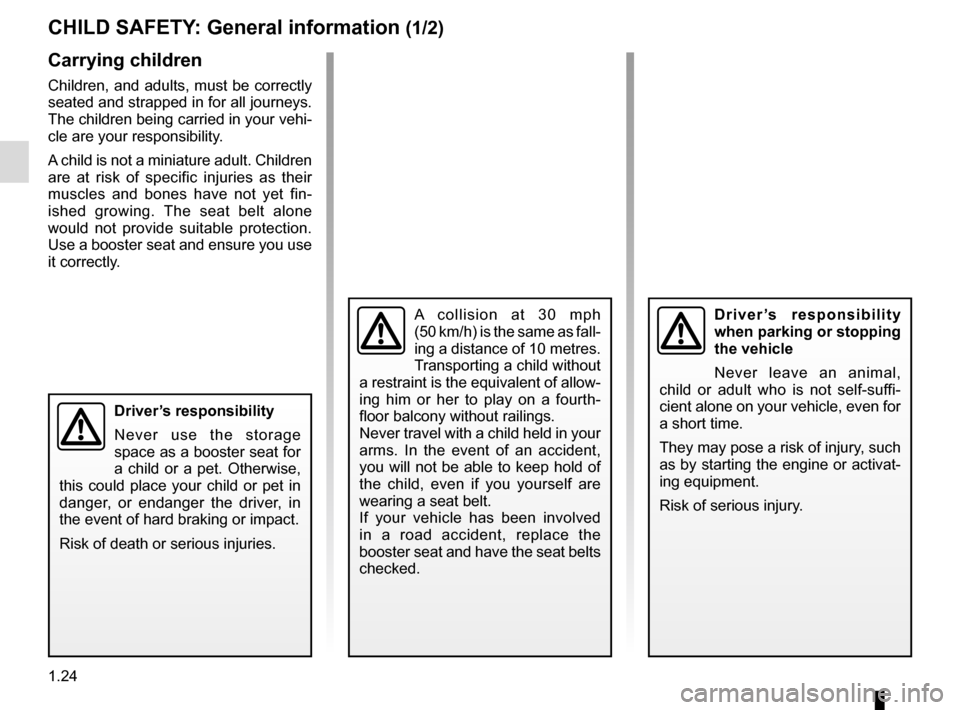
1.24
CHILD SAFETY: General information (1/2)
Carrying children
Children, and adults, must be correctly
seated and strapped in for all journeys.
The children being carried in your vehi-
cle are your responsibility.
A child is not a miniature adult. Children
are at risk of specific injuries as their
muscles and bones have not yet fin-
ished growing. The seat belt alone
would not provide suitable protection.
Use a booster seat and ensure you use
it correctly.
A collision at 30 mph
(50 km/h) is the same as fall-
ing a distance of 10 metres.
Transporting a child without
a restraint is the equivalent of allow-
ing him or her to play on a fourth-
floor balcony without railings.
Never travel with a child held in your
arms. In the event of an accident,
you will not be able to keep hold of
the child, even if you yourself are
wearing a seat belt.
If your vehicle has been involved
in a road accident, replace the
booster seat and have the seat belts
checked.Driver’s responsibility
when parking or stopping
the vehicle
Never leave an animal,
child or adult who is not self-suffi-
cient alone on your vehicle, even for
a short time.
They may pose a risk of injury, such
as by starting the engine or activat-
ing equipment.
Risk of serious injury.
Driver’s responsibility
Never use the storage
space as a booster seat for
a child or a pet. Otherwise,
this could place your child or pet in
danger, or endanger the driver, in
the event of hard braking or impact.
Risk of death or serious injuries.
Page 38 of 118
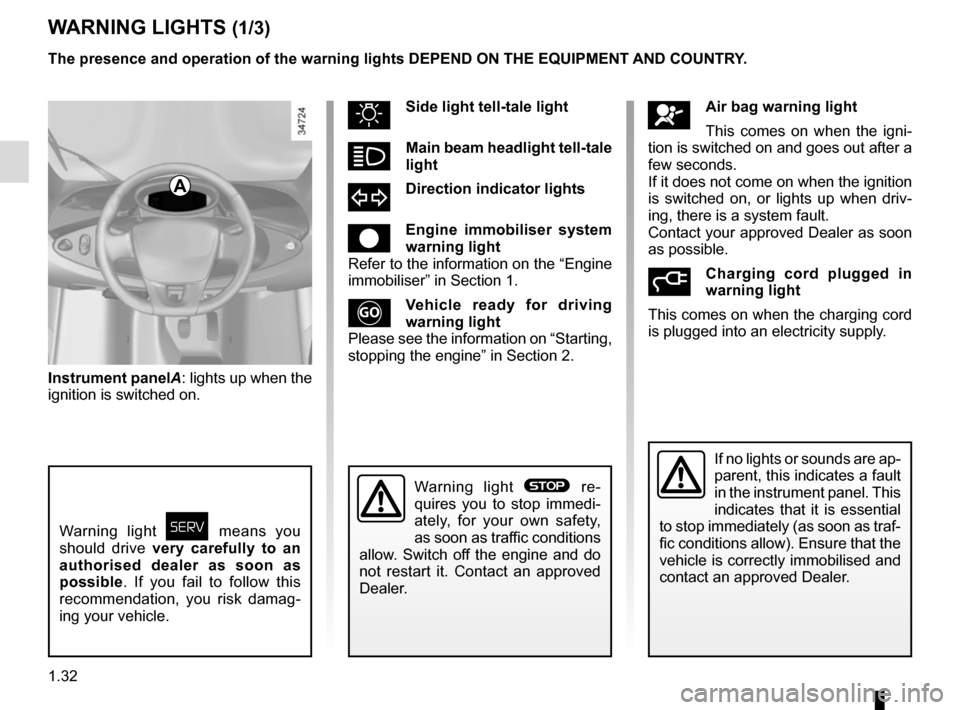
1.32
Instrument panelA: lights up when the
ignition is switched on.
WARNING LIGHTS (1/3)
Warning light ø means you
should drive very carefully to an
authorised dealer as soon as
possible. If you fail to follow this
recommendation, you risk damag-
ing your vehicle.
A
åAir bag warning light
This comes on when the igni-
tion is switched on and goes out after a
few seconds.
If it does not come on when the ignition
is switched on, or lights up when driv-
ing, there is a system fault.
Contact your approved Dealer as soon
as possible.
Charging cord plugged in
warning light
This comes on when the charging cord
is plugged into an electricity supply.
uSide light tell-tale light
áMain beam headlight tell-tale
light
dDirection indicator lights
êEngine immobiliser system
warning light
Refer to the information on the “Engine
immobiliser” in Section 1.
Vehicle ready for driving
warning light
Please see the information on “Starting,
stopping the engine” in Section 2.
If no lights or sounds are ap-
parent, this indicates a fault
in the instrument panel. This
indicates that it is essential
to stop immediately (as soon as traf-
fic conditions allow). Ensure that the
vehicle is correctly immobilised and
contact an approved Dealer.
Warning light ® re-
quires you to stop immedi-
ately, for your own safety,
as soon as traffic conditions
allow. Switch off the engine and do
not restart it. Contact an approved
Dealer.
The presence and operation of the warning lights DEPEND ON THE EQUIPMENT\
AND COUNTRY.
Page 39 of 118
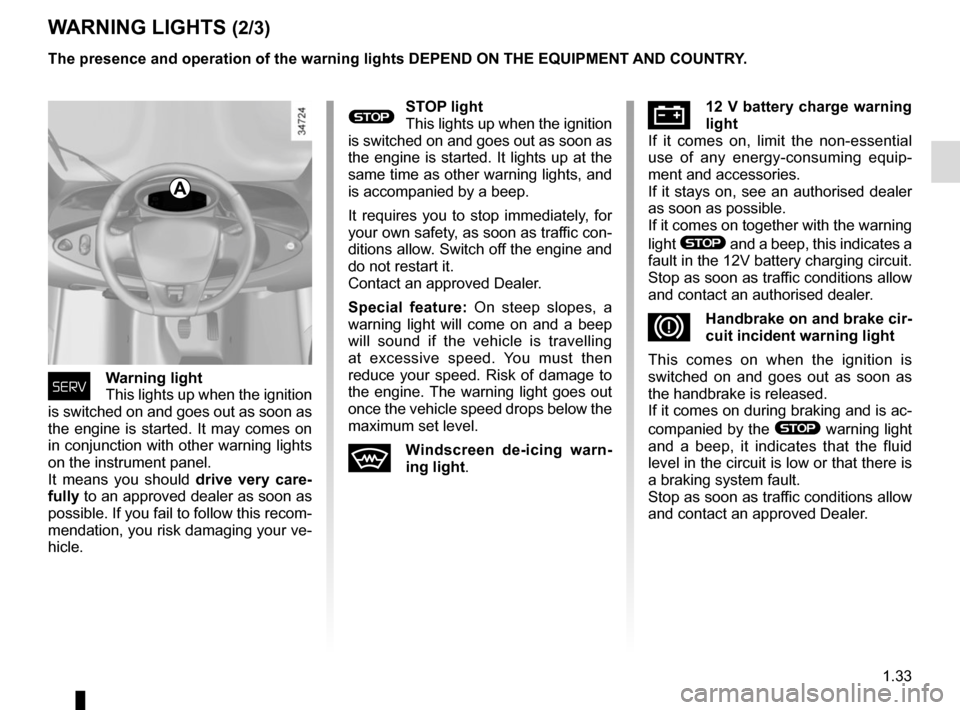
1.33
WARNING LIGHTS (2/3)
®STOP light
This lights up when the ignition
is switched on and goes out as soon as
the engine is started. It lights up at the
same time as other warning lights, and
is accompanied by a beep.
It requires you to stop immediately, for
your own safety, as soon as traffic con-
ditions allow. Switch off the engine and
do not restart it.
Contact an approved Dealer.
Special feature: On steep slopes, a
warning light will come on and a beep
will sound if the vehicle is travelling
at excessive speed. You must then
reduce your speed. Risk of damage to
the engine. The warning light goes out
once the vehicle speed drops below the
maximum set level.
Windscreen de-icing warn-
ing light .
Ú12 V battery charge warning
light
If it comes on, limit the non-essential
use of any energy-consuming equip-
ment and accessories.
If it stays on, see an authorised dealer
as soon as possible.
If it comes on together with the warning
light
® and a beep, this indicates a
fault in the 12V battery charging circuit.
Stop as soon as traffic conditions allow
and contact an authorised dealer.
DHandbrake on and brake cir-
cuit incident warning light
This comes on when the ignition is
switched on and goes out as soon as
the handbrake is released.
If it comes on during braking and is ac-
companied by the
® warning light
and a beep, it indicates that the fluid
level in the circuit is low or that there is
a braking system fault.
Stop as soon as traffic conditions allow
and contact an approved Dealer.
The presence and operation of the warning lights DEPEND ON THE EQUIPMENT\
AND COUNTRY.
A
øWarning light
This lights up when the ignition
is switched on and goes out as soon as
the engine is started. It may comes on
in conjunction with other warning lights
on the instrument panel.
It means you should drive very care-
fully to an approved dealer as soon as
possible. If you fail to follow this recom-
mendation, you risk damaging your ve-
hicle.
Page 40 of 118
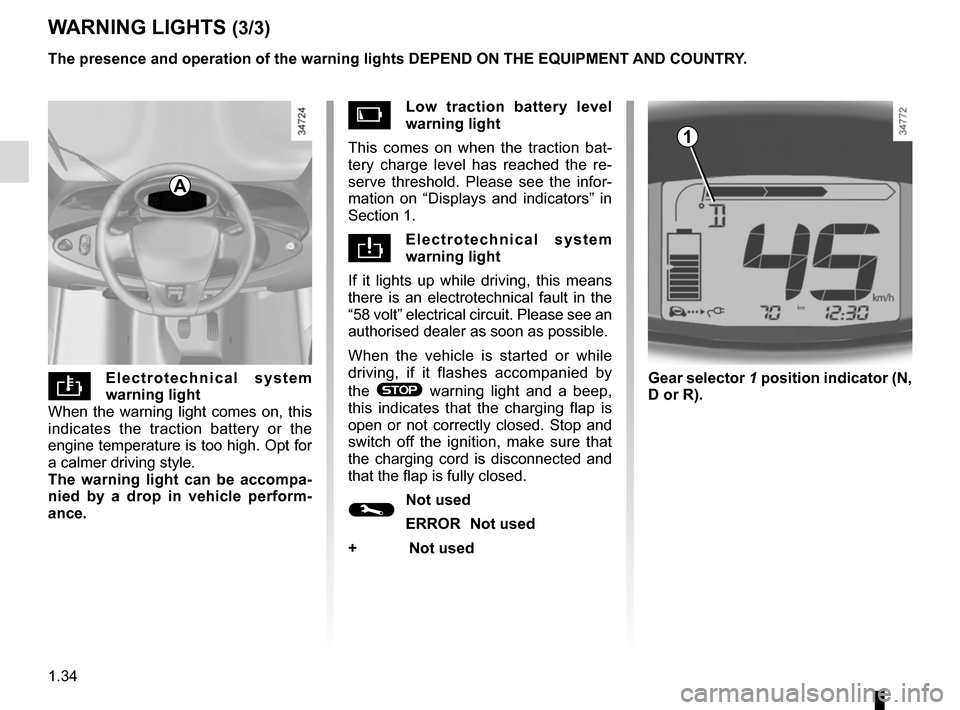
1.34
Low traction battery level
warning light
This comes on when the traction bat-
tery charge level has reached the re-
serve threshold. Please see the infor-
mation on “Displays and indicators” in
Section 1.
\bElectrotechnical system
warning light
If it lights up while driving, this means
there is an electrotechnical fault in the
“58 volt” electrical circuit. Please see an
authorised dealer as soon as possible.
When the vehicle is started or while
driving, if it flashes accompanied by
the
® warning light and a beep,
this indicates that the charging flap is
open or not correctly closed. Stop and
switch off the ignition, make sure that
the charging cord is disconnected and
that the flap is fully closed.
©Not used
ERROR Not used
+ Not used
WARNING LIGHTS (3/3)
Electrotechnical system
warning light
When the warning light comes on, this
indicates the traction battery or the
engine temperature is too high. Opt for
a calmer driving style.
The warning light can be accompa-
nied by a drop in vehicle perform-
ance. The presence and operation of the warning lights DEPEND ON THE EQUIPMENT\
AND COUNTRY.
A
Gear selector 1 position indicator (N,
D or R).
1
Page 49 of 118
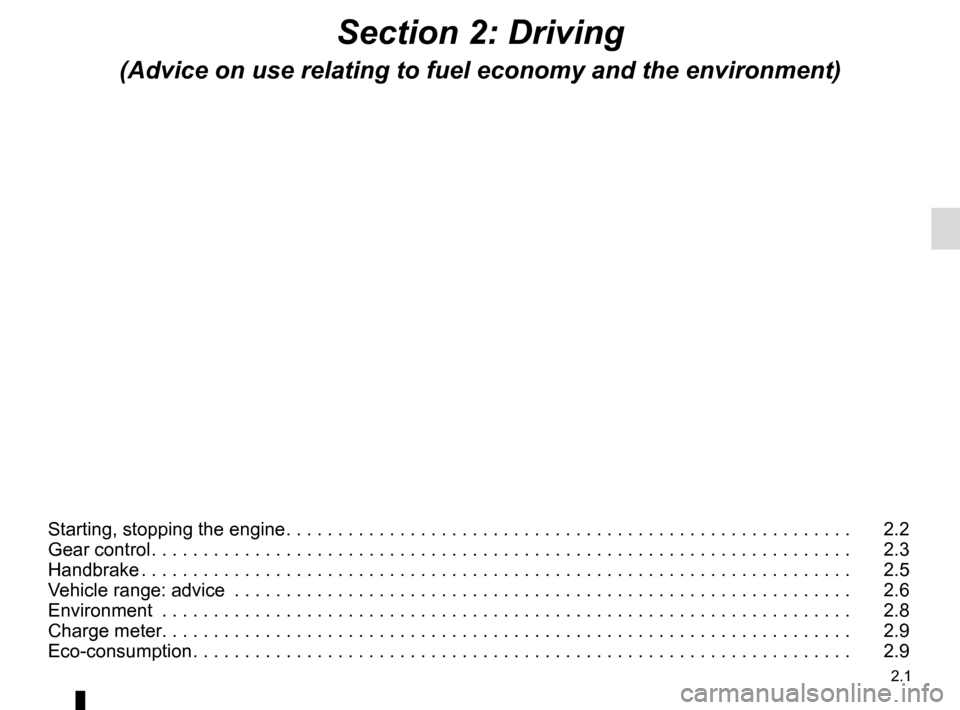
2.1
Section 2: Driving
(Advice on use relating to fuel economy and the environment)
Starting, stopping the engine . . . . . . . . . . . . . . . . . . . . . . . . . . . . . . . . . . . . \
. . . . . . . . . . . . . . . . . . . 2.2
Gear control . . . . . . . . . . . . . . . . . . . . . . . . . . . . . . . . . . . . \
. . . . . . . . . . . . . . . . . . . . . . . . . . . . . . . . 2.3
Handbrake . . . . . . . . . . . . . . . . . . . . . . . . . . . . . . . . . . . . \
. . . . . . . . . . . . . . . . . . . . . . . . . . . . . . . . . 2.5
Vehicle range: advice . . . . . . . . . . . . . . . . . . . . . . . . . . . . . . . . . . . .\
. . . . . . . . . . . . . . . . . . . . . . . . 2.6
Environment . . . . . . . . . . . . . . . . . . . . . . . . . . . . . . . . . . . .\
. . . . . . . . . . . . . . . . . . . . . . . . . . . . . . . 2.8
Charge meter. . . . . . . . . . . . . . . . . . . . . . . . . . . . . . . . . . . . \
. . . . . . . . . . . . . . . . . . . . . . . . . . . . . . . 2.9
Eco-consumption . . . . . . . . . . . . . . . . . . . . . . . . . . . . . . . . . . . . \
. . . . . . . . . . . . . . . . . . . . . . . . . . . . 2.9
Page 50 of 118
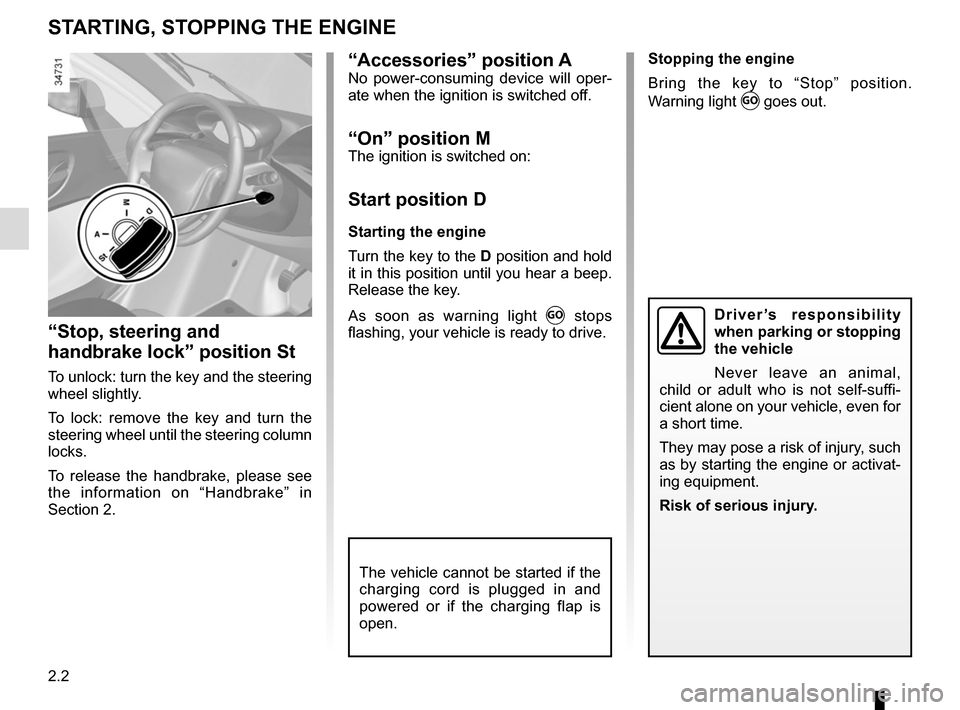
2.2
“Accessories” position ANo power-consuming device will oper-
ate when the ignition is switched off.
“On” position MThe ignition is switched on:
Start position D
Starting the engine
Turn the key to the D position and hold
it in this position until you hear a beep.
Release the key.
As soon as warning light
Ṑ stops
flashing, your vehicle is ready to drive.“Stop, steering and
handbrake lock” position St
To unlock: turn the key and the steering
wheel slightly.
To lock: remove the key and turn the
steering wheel until the steering column
locks.
To release the handbrake, please see
the information on “Handbrake” in
Section 2.
STARTING, STOPPING THE ENGINE
The vehicle cannot be started if the
charging cord is plugged in and
powered or if the charging flap is
open.
Stopping the engine
Bring the key to “Stop” position.
Warning light
Ṑ goes out.
Driver’s responsibility
when parking or stopping
the vehicle
Never leave an animal,
child or adult who is not self-suffi-
cient alone on your vehicle, even for
a short time.
They may pose a risk of injury, such
as by starting the engine or activat-
ing equipment.
Risk of serious injury.
Page 115 of 118
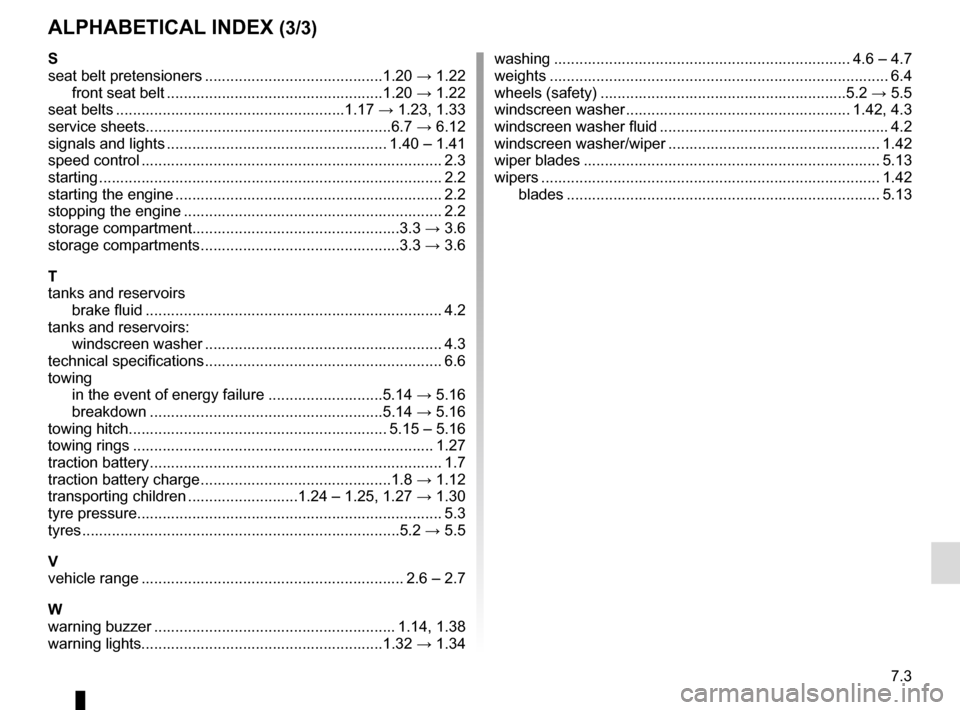
7.3
ALPHABETICAL INDEX (3/3)
S
seat belt pretensioners ..........................................1.20 → 1.22
front seat belt ...................................................1.20 → 1.22
seat belts ......................................................1.17 → 1.23, 1.33
service sheets..........................................................6.7 → 6.12
signals and lights .................................................... 1.40 – 1.41
speed control ....................................................................... 2.3
starting ...............................................................\
.................. 2.2
starting the engine ............................................................... 2.2
stopping the engine ............................................................. 2.2
storage compartment.................................................3.3 → 3.6
storage compartments ...............................................3.3 → 3.6
T
tanks and reservoirs brake fluid ...................................................................... 4.2
tanks and reservoirs: windscreen washer ........................................................ 4.3
technical specifications ........................................................ 6.6
towing in the event of energy failure ...........................5.14 → 5.16
breakdown .......................................................5.14 → 5.16
towing hitch............................................................. 5.15 – 5.16
towing rings ....................................................................... 1.27
traction battery ..................................................................... 1.7
traction battery charge .............................................1.8 → 1.12
transporting children ..........................1.24 – 1.25, 1.27 → 1.30
tyre pressure........................................................................\
5.3
tyres ..................................................................\
.........5.2 → 5.5
V
vehicle range .............................................................. 2.6 – 2.7
W
warning buzzer ......................................................... 1.14, 1.38
warning lights.........................................................1.32 → 1.34washing ...................................................................... 4.6 – 4.7
weights ................................................................\
................ 6.4
wheels (safety) ..........................................................5.2 → 5.5
windscreen washer ..................................................... 1.42, 4.3
windscreen washer fluid ...................................................... 4.2
windscreen washer/wiper .................................................. 1.42
wiper blades ...................................................................... 5.13
wipers .................................................................\
............... 1.42 blades .................................................................\
......... 5.13